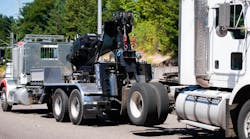The Federal Motor Carrier Safety Administration (FMCSA) revealed its roll -out plan to Congress this week for its revamped safety scoring process for the trucking industry called Comprehensive Safety Analysis 2010 (CSA 2010). While the new program drew praise from truckers and safety experts, concerns were also expressed-- namely over the data collection and analysis portion of the new rules.
Anne Ferro, FMCSA Administrator, said in testimony before the House of Representative’s Committee on Transportation and Infrastructure that the key components of CSA 2010 will be revealed in stages starting this August and the new process should go into full effect sometime in 2011.
The new Carrier Safety Measurement System (CSMS) will replace the current safety scoring system, SAFESTAT, and will measure carriers more thoroughly through the use of all safety violation data, weighted by crash risk.
“CSMS will give our investigators a more robust tool to use in identifying high risk carriers for review,” Ferro stressed. “It also will be the basis for the selection system roadside enforcement officers will use to focus their roadside inspections.”
With regard to process, CSA 2010 introduces a new strategy known as the “intervention,” and frames it at four levels: comprehensive on-site reviews (much like today’s compliance review); focused on-site investigations; off-site investigations; and warning letters.
“Through a mix of these interventions, combined with roadside activity, we will increase the number of carriers we “touch” and catch unsafe behaviors before it leads to a crash,” Ferro said.
Finally, for maximum effect, Ferro said CSA 2010 will be grounded on a new piece of regulation, known as the Safety Fitness Determination Rule.
“This rule will decouple the carrier safety rating from today’s on-site compliance review [and] will enable FMCSA to propose carrier safety ratings through the CSMS, thereby increasing the number of carriers we rate annually ten-fold,” Ferro explained.
The notice for proposed rulemaking (NPRM) for this new regulation is expected in early 2011 and Ferro noted that much of CSA won’t be fully active until next year..
“The roll-out for CSA 2010 officially began in April this year with the launch of the data preview, with the actual CSMS system to be previewed in late August, followed by full view to the public at the end of the year,” she said. “Remaining components – warning letters, the NPRM, intervention process and more – will continue to the end of fiscal year 2011.”
By that time, CSA 2010 will be known only by its initials “CSA,” which will stand for “Compliance, Safety, Accountability,” Ferro added.
While the American Trucking Assns. (ATA) said it supports CSA 2010's overall objectives, it contends that there are major “flaws” relating to how the new program will actually work . These flaws could harm safe carriers while allowing unsafe ones to continue operating, stressed Keith Klein, executive vp & COO of truckload carrier Transportation Corporation of America, testifying on behalf of ATA.
To avoid these consequences, Klein said that FMCSA should delay the implementation of CSA 2010 until the agency gets a chance to review an evaluation study of the program currently underway by the University of Michigan Transportation Research Institute.
In particular, ATA has three major concerns: Crash accountability or "causation" determinations should be made on truck-involved crashes before entering them into a carrier's record so drivers and carriers are held accountable only for crashes they cause; vehicle miles traveled (VMT) and not number of trucks or power units should be used as a carrier's “exposure measure”; and the agency should focus on using only actual citations for moving violations, not un-adjudicated "warnings" issued by law enforcement.
Klein said that in addition to those issues, ATA is also concerned about how the severity weights for violations are assigned; measuring carriers based on violations committed by drivers who have since been terminated; measuring carriers based on citations that have been dismissed in a court of law; inequitable measurement of open deck or flatbed carriers; overly broad peer groups; and inconsistent state enforcement practices.
"A system that is based on inconsistent data and a flawed scoring methodology will not achieve its objectives,” Klein stressed. “Instead, it will create inequities for some safe carriers and inappropriately allow some unsafe carriers to avoid scrutiny and consequences.”
Industry observers also caution fleet owners and others to expect glitches to crop up in the CSA 2010 process as it gets rolled out. “With a program of this size and scope there are bound to be some bumps along the way,” said Stephen Keppler, interim executive director of the Commercial Vehicle Safety Alliance (CVSA).
“The key to success is to keep an open line of communication and for FMCSA to work together with the states, industry and other affected parties to ensure they are fully aware of what is happening and when,” Keppler said in his Congressional testimony.
This, however, requires a long-term and sustained federal investment and needs to be appropriately funded at both the federal and state levels for it to be successful, Keppler said. “A glimpse of the additional resources needed at the federal level for CSA 2010 is evidenced by the President’s request for an additional $20 million beyond SAFETEA-LU authorized limits for his Fiscal Year 2011 budget for the purpose of rolling out CSA 2010,” he noted.


